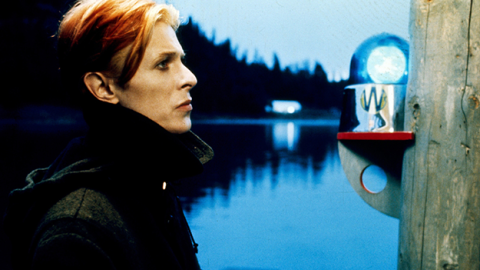Sexy Beast
Instead of a syrupy hagiography or meticulously researched list of people and art forms he borrowed/stole from, here’s a chronological list of my most powerful memories of David Bowie: frenetically dancing around the living room to “Modern Love” as a 7-year-old wearing a bathing suit and bike shorts; going through the giant stack of vinyl in that same living room at 13, discovering both Ziggy Stardust and the Spiders from Mars and Pinups, and instantly becoming obsessed with glam rock; at 15, renting a suit and dyeing a blonde mullet-wig red to dress up like Bowie in the “Life on Mars?” video for Halloween, subsequently winning a costume contest at a local punk show; realizing Velvet Goldmine is a total piece of shit at 18; feeling some spiritual emptiness at 27 and listening to the glorious trio of Station to Station, Low, and Heroes over and over again for months. Then again, Bowie looms large for anyone who’s ever attempted an iron-on personality, who realize people do mercilessly judge you by the way you look, and that the characters you invent can become who you are all the time.

The Man Who Fell to Earth
Of course, transformation takes more than just desire: it also requires skill and verisimilitude. (Example: Garth Brooks’s wretchedly awful turn as Chris Gaines.) Choosing roles as discerningly as he does his musical projects, Bowie is undoubtedly among the best singers-turned-actors. With his unmistakable gentle yet stilted delivery, his presence in a film is always a mark of enunciation. We are no longer inside a diegesis; we are watching a film with David fucking Bowie in it. This distancing effect is used brilliantly in the BBC’s production of Baal (82, adapted by Alan Clarke and preeminent Bertolt Brecht scholar John Willett), and in his first and finest acting performance, The Man Who Fell to Earth (76). Opening with Bowie sliding around in the dirt of the barren, Mars-like landscape of New Mexico, his shock of red hair gleaming in the sun, “Thomas Jerome Newton” is a facsimile of a human being that immediately calls attention to itself despite getting the big details right. But then, it’s a facsimile that gets the small, crucial details wrong, sometimes humorously (his grimacing, attempted lip-synch to the hymn “Jerusalem” at Mary-Lou’s church), sometimes dangerously (not knowing the significance of “Per Ardua ad Astra.”) With Roeg’s trademark quick, overlapping edits, the true limits of Newton’s alien powers remain murky, though his rock ’n’ roll downfall—which includes a lone hit album that carries a message to the stars and gallons of gin—is plumbed thoroughly.

Absolute Beginners
While The Man Who Fell to Earth was in many ways tailor-made for Bowie, it isn’t the only performance that has some connection to his musical work or overall persona at the time. As the vampire John Blaycock in The Hunger (83), made in that odd period between Scary Monsters (And Super Creeps) and Let’s Dance, he puts the Dorian Gray complex of pop stardom onto center stage: there comes a time when you’re physically unable to suck any more life out of youth. Julien Temple’s Absolute Beginners (86), a fairly appalling adaptation of Colin MacInnes’s memoirs of the nascent rock scene in Fifties London, features a Bowie appearance that’s just as shameless a cash-grab as his utterly lazy 1987 album Never Let Me Down. Appropriately playing ruthless ad executive Vendice Partners, Bowie tap-dances on top of a giant typewriter during a musical sequence, a display of excess that simultaneously attracts and repels. His other musical mid-Eighties performance as Jareth, the Goblin King in Labyrinth (86)—opposite Jennifer Connelly and a hoard of Muppets—toes the line between camp and crass materialism less problematically. But where Beginners pairs London’s painful recent history of gentrification and race riots with trite song and dance, Labyrinth is an unabashedly goofy Jim Henson–sanctioned family night out. (There’s also an argument to be made that his costume, a lavender leotard that fails to conceal the size of his penis, is utterly subversive.) His latter-day outings as elder statesmen in their respective fields—Andy Warhol in Basquiat (96) and Nikola Tesla in The Prestige (06)—are serious, confident performances that reflect his own rock canonization, as well as his return to less obviously commercial musical projects.

Basquiat
While no one has filmed (or, more accurately, been allowed to film) the staged or backstage of his tours after 1983, his first pass at worldwide superstardom has been immortalized in two documentaries: D.A. Pennebaker’s remarkable Ziggy Stardust and the Spiders from Mars (73) and Alan Yentob’s darkly fascinating Cracked Actor (75). While the first captures Bowie killing off Ziggy in a final performance of the character, Cracked Actor shows the psychological attrition born of playing a character and intense fame. The expatriated Bowie vaguely admits to having suicidal thoughts, guzzles milk straight from the carton, and preps his “plastic soul” songs of Young Americans. Yet the hour-long documentary, made for BBC’s “Omnibus” series, is just as much a monument to his fans. The grease-painted, bi-curious oddballs hanging out in a Los Angeles parking lot after one of his concerts are no different than the little German junkie Christiane F., who dies her hair that Low-era brilliant red and descends into the hell of Neukoln’s train-station toilets. Powered by the best instrumental tracks of the aforementioned trifecta of middle-period prog-rock albums (Station to Station/Low/Heroes), Christiane F. (81) boasts a rarity: the singer plays himself in a mind-blowing live performance in Berlin. (It also has a rather impressive German-language version of “Heroes,” though minus the technical genius of the original, co-produced by Bowie and Tony Visconti.) That wouldn’t be the last time that Bowie was his own best role, but who’s counting? The perpetual role-player can be nostalgic too.




